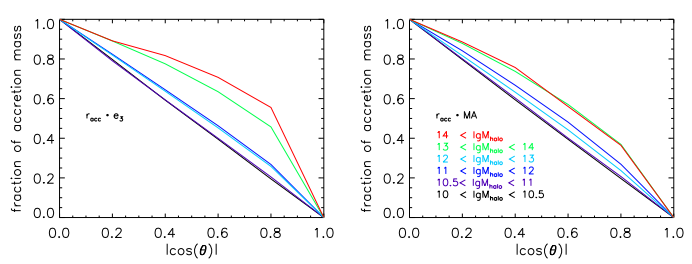Observations in recent years have found that galaxies are not randomly distributed in the universe, but display different anisotropy on both large and small scales. However, it is not clear what is origin of such anisotropy. The galaxy and cosmology group at Purple Mountain Observatory, Chinese Academy of Science, has carried out a research well explains the origin of galaxy anisotropic distribution. The paper is published in the Astrophysical Journal (2015, ApJ, 813,6). 
By with KANG Xi Fig.1 displays the anisotropy of mass accretion along the halo major axis (left), and along the large scale structure (right panel). The accretion is universal in the left panel, but it is dependent on host halo mass for alignment with the large scale structure, as seen in the right panel Prof. Xi Kang and his student, Peng Wang, make use of a N-body simulation to investigate how the mass is accreted into dark matter halo and quantify the degree of anisotropy at the time of accretion respect to the halo major axis and the large scale structure. They found that 1)subhaloes are predominately accreted along the major axis of dark matter halo, and the alignment is stronger in massive haloes. 2)the accretion of mass along the large scale structure (taking the filament direction), is not universal. In low-mass haloes, mass are accreted in the plane vertical to the filament, but in high-mass haloes, mass are accreted along the filament. By assuming that the orbital angular momentum is transferred to halo spin, it is predicted that the spin of low-mass halo is parallel to the filament, but spin of high-mass halo is vertical to filament. Such a prediction is in agreement with the observations from the SDSS by Tempel et al. in 2013. |
